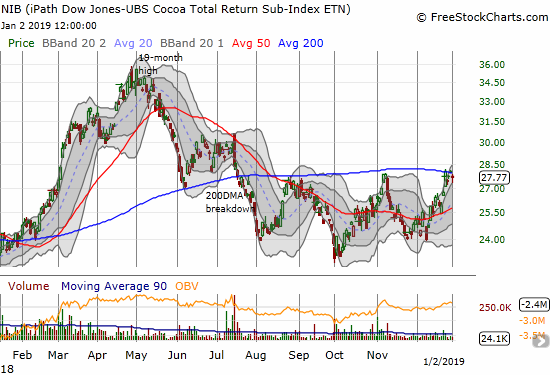Almost three years ago, I seized on an opportunity to buy iPath Bloomberg Cocoa SubTR ETN (NIB) after it sold off steeply from a strong 2015. In that year, cocoa ripped ahead of the rest of the commodity space which declined 19% in 2015 while cocoa rallied 10%.
In 2018, cocoa was another strong performer. CNBC reported that cocoa futures gained 28% last year and topped the list of major futures markets. The celebration ignores some important technical and fundamental features that make the annual yardstick a bit misleading. For example, NIB rallied sharply in the beginning of 2018 and was up as much as 51% year-to-date at the end of April. In just 5 subsequent months, NIB wiped out almost its entire gain for the year. NIB rallied 16% in just the last three weeks of the year to finish up 23.0% for 2018. Moreover, NIB has struggled for over 5 months with its 200-day moving average (DMA) after breaking down below that important trendline in mid-July. NIB is currently on its third test of 200DMA resistance, and the line is trendless. In other words, cocoa’s “strong” performance in 2018 is quite fortuitous. The clock happened to stop right at the last price rally from much lower levels.

Source: FreeStockCharts.com
When cocoa was breaking out in early 2018 as part of a recovery from 2017 lows, I noted how the market was primed for a rally given so much negative news was already priced into futures. So when Ghana projected a miss on its production target, cocoa prices had nowhere to go but up given the potential for supply to come up short. Unfortunately, cocoa went from one extreme to another. The peak in April made little sense given the cocoa market remained well-supplied. In early April and again in late May, I explained the case for a top in cocoa prices.
Given this price history, I was a bit dismayed to read CNBC (and other outlets) relay the claim of an analyst that a supply shortfall of a few tons helped explain cocoa’s gains in 2018: “Main crop production ideas for Ivory Coast and Ghana are being reduced, with Ivory Coast now estimating its main crop production at 1.985 million tons, down from previous estimates just over 2.0 million tons.” Talk about fishing for explanations! The analyst’s description of strong demand is a much more likely catalyst, but as a force preventing cocoa from falling further and NOT as a force propelling cocoa higher.
The latest “Monthly Review of the Cocoa Market Situation” from the International Cocoa Organization (ICCO) covers November, 2018. At the time cocoa futures were in the process of making another bottom in a multi-month trading range. The ICCO blamed the latest price weakness on ample supplies and purchases in Ghana and Ivory Coast. Moreover, “a mix of rain and sunshine and the fact that new plantings started to produce cocoa pods pressured down cocoa prices during the considered period.” Moreover, supplies from the Ivory Coast were up significantly year-over-year: a 35% gain from 510,000 tonnes to 689,000 tonnes.
Fortunately, demand was growing robustly to meet the supplies. I am guessing that prices significantly off the highs of the year were encouraging the rush to buy and process cocoa (emphasis mine):
“…an increase in world grindings of 3.9% during the last crop season. Grindings reached a record 4.570 million tonnes, up by 173,000 tonnes. This new estimate reflects the unabated increase in demand which is especially reflected in the steady cocoa processing growth in origin countries. Processing activities grew of 5.1% to 1.711 million tonnes in Europe and by 4.3% to 1.031 million tonnes in Asia and Oceania whereas Africa’s increase was by 5.7% to 951,000 tonnes. In contrast, grindings
in the Americas slightly regressed by 0.3% from the previous season to 877,000 tonnes.”
Demand will have to continue trending upward to keep prices propped up. For example, Ghana expects to double production in eight years. From News Ghana:
“The Ghana Cocoa Board (COCOBOD) in collaboration with the Forestry Commission and support from the United Nations (UN) Food and Agriculture Organization (FAO) has been implementing a shift from mono-cropping towards agro-forestry plantation based practice…
It is expected that under the new program the yield per hectare will move from 450 kilos to a yield of close to 800 kilos to make a big difference of more income to farmers.”
Only strong demand will be able to deliver increased income for farmers with such a surge in production.
I currently do not own any shares in NIB. Per my usual strategy, I bought the dips in NIB (I never short NIB and I also want a bias for farmer-positive action). I have sold at or near key resistance levels. I am still waiting for the key resistance at the 200DMA to break. However, until fundamentals truly change in favor of higher prices, I fully expect NIB to remain rangebound for the time being.
Be careful out there!
Full disclosure: no positions
